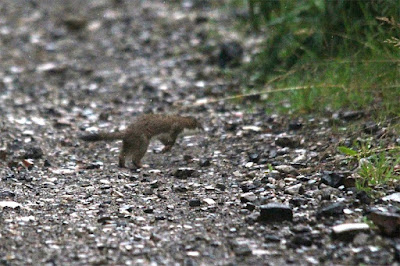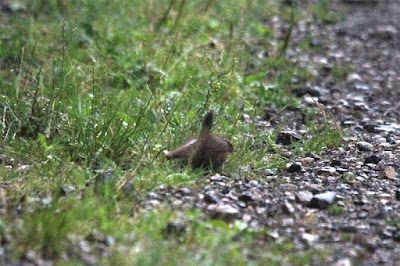 |
| House sparrow, Kenworthy Wood |
It was another relatively cool, cloudy day with a fair breeze and a slight risk of showers and I wondered what to do with it. I entertained all sorts of notions and stressed out about timings and logistics then told myself to calm down and go for a walk. So I got the 101 bus from Manchester, got off on Princess Parkway just before the river and walked down the Mersey into Chorlton.
 |
| River Mersey by Kenworthy Woods |
It was lunchtime as I walked along the Cheshire side of the river by Kenworthy Woods where the wrens were singing loud and proud, the blackcaps and chiffchaffs made occasional song-like noises in the trees and ring-necked parakeets made soft cackling noises deep in the canopy. Blackbirds and blue tits bounced around in the trees either side of the river and there was a steady overhead traffic of woodpigeons and carrion crows. A cock house sparrow foraged on the bank by the path paying absolutely no heed to me as he busily foraged for insects on the umbels of hogweeds and cow parsleys.
 |
| Large skipper, Kenworthy Wood |
There was a profusion of butterflies, equal numbers of large whites, small tortoiseshells, meadow browns and ringlets with a few large skippers and a couple of commas. They were all very busy and scarcely stayed still as they bustled along the vegetation on the banks. The bumblebees — mostly buff-tailed, I think — seemed even busier. The common blue damselflies at least stopped every so often for a rest.
 |
| Common blue damselfly, Kenworthy Wood |
A grey wagtail flitted about the river bank and half a dozen Canada geese floated upstream in a rather purposeless fashion. I'd just reached the shoals just before the bridge to Chorlton Water Park when a couple of redhead goosanders hurried into the middle of the river and steamed upstream at a rate of knots.
 |
| Goosander, Chorlton |
Chorlton Water Park was relatively quiet of both people and birds. Small rafts of Canada geese and mallards drifted about, a mute swan ferried six large cygnets around and the coots were surprisingly few and far between. A couple of black-headed gulls flew about, a couple of male great crested grebes had a fight and the reed warbler sang from the tiny scrap of reeds by the playground.
 |
| Chorlton Water Park |
All the small birds had congregated in the trees at the Northwest corner of the lake: a blackcap and a chiffchaff sang while families of blue tits, long-tailed tits and goldfinches bounced around in the treetops. I was thinking it odd not to have heard or seen a robin when I nearly tried on one. I was apologising for my clumsiness when I noticed a treecreeper sidling up the tree trunk behind the robin.
 |
| Juvenile goldfinch, Barlow Tip |
Barlow Tip was awash with dragonflies and butterflies. Common blue damselflies zipped around all over the place. I couldn't see any candidates for other species of damselfly amongst the crowds. Southern hawkers and brown hawkers patrolled the thistle tops, occasionally their erratic trajectories would coincide and there'd be a few seconds' dogfight before they went their separate ways. I expect each would see the other as a decent meal given half a chance. A couple of large whites mobbing a brown hawker like house martins mobbing a hobby smacked of recklessness. Half a dozen swifts hawking overhead suggested there were enough small insects about keep the dragonflies going. I spent a while trying and failing to get pictures of hawkers in flight before admitting defeat.
 |
| Small tortoiseshell, Barlow Tip |
Small tortoiseshells, ringlets and meadow browns flitted about the meadow, commas, large whites and a small skipper along the woodland margins. A song thrush sang from deep in the woods, almost drowning out the blackbirds and chiffchaffs. A family of goldfinches busied themselves in the young trees on the meadow while a couple of whitethroats had a singing duel. A family of magpies bounced through the hedgerow by the path back to the river, disturbing a jay in the process.
 |
| Barlow Tip |
I walked down the river to Jackson's Boat. Unusually there was nothing on the river along this stretch. A total absence of hirundines was also noticeable. They've been a bit thin everywhere this month. I haven't walked through a cloud of midges once this year, probably because our hottest June on record has dried up all the ditches, small pools and large puddles a lot earlier than usual. From a selfish point of view I don't miss the midges but I expect the swallows and martins do. Every so often I had to watch my step as caterpillars of red admirals and small tortoiseshells marched across the path from one heat exhausted nettle patch to another.
 |
| River Mersey |
The parakeets at Jackson's Boat were strangely subdued as they flew around the trees. Soft cacklings in the depths of the sycamores suggested that a few youngsters were about. The only swallow of the day flew downriver and over onto Sale Ees.
A couple of lads were canvassing for Sustrans by the bridge to Jackson's Boat. I gave my opinion on the manners of Chorlton's cyclists. They'd been hearing similar all day. A suggestion that they'd widen the paths or have parallel paths for cyclists and pedestrians alarmed me. There's already an extensive network of paths and the Transpennine Route is fairly wide enough so long as both cyclists and pedestrians take care for the other. I reckon what's really needed are traffic calming measures on the straight runs of the route so rogue cyclists can't get their heads down and go for speed like they're on the velodrome, a danger to other cyclists as much as pedestrians. The last thing we want is having natural environment being taken out of the public realm and concreted over so that more cyclists can be arses. I bit my tongue at the suggestion that street lighting be installed along the paths to prevent drug use, I didn't point out that Piccadilly Gardens never sees nightfall.
 |
| Chorlton Ees |
I walked through Chorlton Ees which was quietly busy with mostly invisible birds. The chiffchaffs, blackcaps and whitethroats were heard but not seen, the blackbirds and robins seen but not heard. A family of blue tits briefly poked their heads out of a hawthorn bush and woodpigeons clattered about the treetops. More swifts hawked over the treetops.
 |
| Chorlton Ees |
It was much the same in Ivy Green, a couple of song thrushes and a dunnock adding to the songscape. I walked through and got the bus home the better for taking a more leisurely approach to the day's birdwatching.
 |
| Ivy Green |




















































